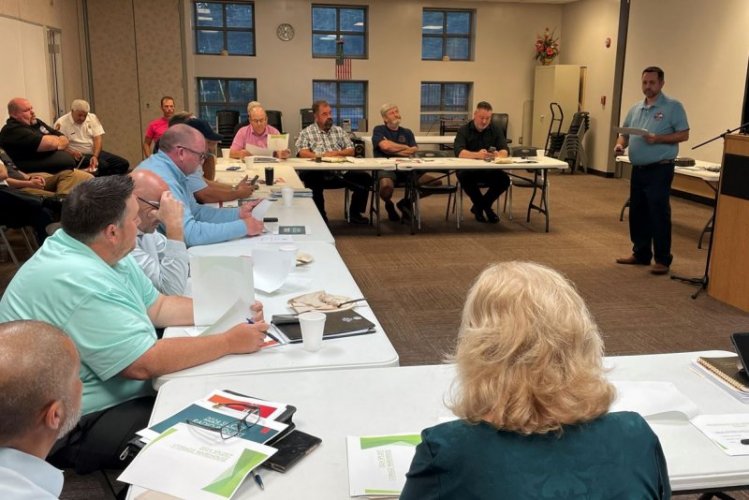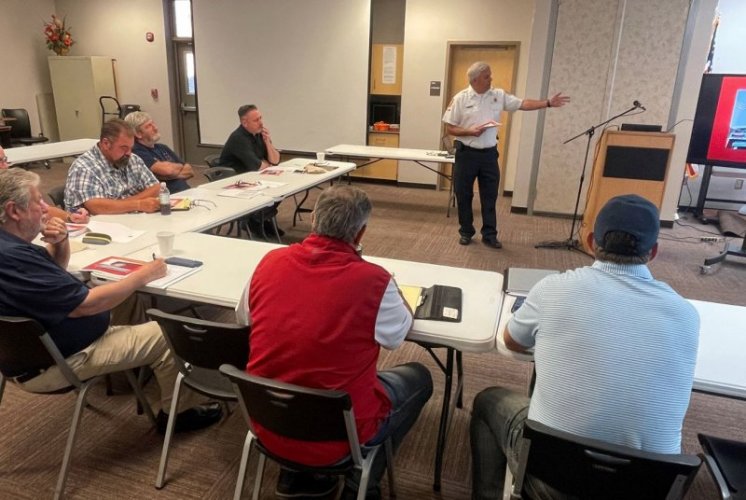Fire Departments, EMA Present To SPLOST Committee
 On Thursday night, the Whitfield County SPLOST Committee held its third meeting to review project requests from the leaders of the Whitfield County Emergency Management Agency (WCEMA) as well as the Dalton and Whitfield County Fire Departments.
On Thursday night, the Whitfield County SPLOST Committee held its third meeting to review project requests from the leaders of the Whitfield County Emergency Management Agency (WCEMA) as well as the Dalton and Whitfield County Fire Departments.
The committee, comprised by residents appointed by the Whitfield County Board of Commissioners and the City Councils of Dalton, Varnell, Tunnel Hill, and Cohutta, has been tasked with reviewing project proposals for inclusion on a potential ballot initiative next May to extend the 1% SPLOST (Special Purpose Local Option Sales Tax). The SPLOST was approved by voters in 2020 and will sunset next October. If voters approve, SPLOST will continue for four more years and fund projects selected by elected officials after recommendations from the committee.
WCEMA Projects
WCEMA Director David Metcalf was the last to present on Thursday night, but his presentation featured the first “Tier 1” project proposed for the committee’s review: the purchase of new portable radios to replace the aging units used by first responders in the county. Tier 1 projects are those projects that benefit the county as a whole.
Caption: WCEMA Director David Metcalf presents a proposal for the purchase of new radios to the SPLOST Committee Thursday night at the Mack Gaston Community Center
A SPLOST measure approved by voters in 2015 funded the creation of a new digital radio network for first responders that dramatically improved emergency communications within Whitfield County, virtually eliminating “dead zones” where emergency personnel were unable to send and receive radio transmissions. The radio network itself is still in good working order, but the individual radios used by police, fire, EMS, and public works personnel are reaching the end of their useful lives. Some of the radios are already at “end of support” where the manufacturer will no longer service them. The entire stock of radios will reach “end of support” in 2027.
There are currently 1,157 radio units in use in the county including 519 “mobile” radios mounted in vehicles and 638 “portable” or handheld units used by personnel in the field. Replacing all 1,157 radios would cost approximately $8 million, while only replacing the portables would cost approximately $4.8 million. Metcalf’s recommendation was to replace the portables only.
“The mobiles last a long time. They will eventually need to be replaced but to me they’re not the major priority right now,” Metcalf told the committee. “The major priority is the portables, that’s what being used day in and day out, in the fires, being dropped.”
Metcalf also requested funding to construct a storage facility to keep vehicles and equipment used by various county agencies out of the weather. The Emergency Management Agency as well as the county’s transit agency and the Buildings and Grounds Department all have equipment currently stored outdoors and therefore exposed to the elements. Metcalf noted that the county’s Mobile Command Vehicle, purchased with grant money in 2005 for more than $600,000, is currently parked outside.
“We just spent $50,000 on repairs for it on the mast that has our camera system, lighting, leveling system, and all of that stuff because it had just degraded from sitting out in the weather,” Metcalf said.
Construction of a 2,900 square foot “pole barn”-type storage structure would cost approximately $85,000 thanks to an estimated $30,000 in savings by having county personnel handle the construction work.
 WCFD Projects
WCFD Projects
The Whitfield County Fire Department (WCFD) presented a number of requests to the SPLOST committee on Thursday night, with Chief Ed O’Brien noting that his department is in a unique position because its budget exists in a special tax district. That means that the county cannot transfer funds from one area of the general fund budget to the fire department in cases of emergency. The WCFD instead pays the county for human resources, finance, and administrative support and while it can borrow from the general fund, it must pay back anything borrowed before the next budget year.
Caption: Whitfield County Fire Chief Ed O'Brien presents project proposals to the SPLOST Committee
Chief O’Brien’s most important request was for the purchase of four new pumper truck fire engines and two battalion chief vehicles. The four engines that are up for replacement are reaching the ends of their life spans. Two of the engines were built in 2001 and the others were built in 2005 and 2006. The engines have more than 9,000 operating hours which is the equivalent of more than 380,000 miles (fire engines may not travel a great distance but their engines run for the entire duration of a fire call in order to keep equipment working). The cost to replace these vehicles would be approximately $3.4 million.
The WCFD’s second request was for approximately $1.4 million to replace the department’s burn building which is used for training exercises. The existing burn building, built in 2007, is comprised of metal shipping containers modified to serve as a training structure.
“It’s been burned in so many times that it’s got significant damage,” Chief O’Brien said. “We’ve done two major remodels with it, but now it’s time to replace it. It’s time as a community to keep these guys safe to replace that facility.”
The third request from WCFD was for approximately $1.6 million to replace the agency’s stock of SCBAs (Self Contained Breathing Apparatus) used by firefighters. The department’s current SCBAs are nine years old and are becoming more difficult and expensive to maintain. In fact, Chief O’Brien said that the department has already spent this year’s budget for servicing the units due to rising costs. Chief O’Brien also noted that newer SCBAs are easier to disassemble and clean more thoroughly which can help eliminate carcinogens that firefighters and their air packs are exposed to during fires.
The department’s fourth request covers building maintenance and renovations to some of the department’s stations. O’Brien noted that upgrades to Stations 1-6 have been carried out thanks to previous SPLOST initiatives and work on stations 7, 8, 9, and 10 is still needed. Chief O’Brien noted that some of the department’s older stations were built without bathroom facilities for women. He noted that each of Stations 7-10 needed new roofs. This request was for $550,000.
Additional, lower priority requests presented by the WCFD for review included the purchase of a mobile air fill vehicle to resupply oxygen to SCBAs at incident sites ($485,000), water tender trucks with larger capacity water tanks ($1.4 million), an all-hazards rescue vehicle ($2.1 million), an additional aerial ladder truck for the west side of the county ($1.6 million), and the construction of a possible new Station #13 in the Beaverdale Road/River Road area to improve service in that area and lower insurance costs for neighboring residents.
 Dalton Fire Department Projects
Dalton Fire Department Projects
The Dalton Fire Department (DFD) presented two project requests to the SPLOST Committee on Thursday night. Former Fire Chief Todd Pangle, now the city’s assistant city administrator, presented requests for a new 100-foot aerial apparatus and funding to relocate Station #2 further south along Abutment Road from its current location.
Caption: Assistant city administrator Todd Pangle presents to the SPLOST Committee
Tower 1, the department’s current front-line 100-foot aerial, is ten years into its planned 20-year service for the agency. Pangle noted that the DFD plans for its fire trucks to serve 15 years as a “first-out” apparatus, meaning it is used during day to day operation. For the next five years, it is used a reserve vehicle when the first-out apparatus is out of service. After that, the apparatus is sold at auction to try to recoup some costs. Pangle said the department is working to order Tower 1’s replacement now because it takes the supplier between 26 and 48 months to deliver new trucks. Pangle also said that by ordering the new apparatus soon, the city can expect to save money because prices for the vehicles are going up between 8 to 14 percent each year. If the contract is completed this year, the cost for a new aerial apparatus would be $2.6 million.
Relocating Station #2 further to the south has been recommended by studies of the department as far back as 2001, Pangle said. Station #2 currently is located inside the district for Station #1, and their optimum coverage areas overlap. Pangle says the department can get a better distribution of coverage for the southern part of the city as well as more credit from the ISO (Insurance Services Office) if a new Station #2 were built further south. Additionally, the relocation of Station #2 would allow the city to expand the fire department’s training center at the current site for use by both the DFD and the Dalton Police Department.
“We plan to partner with the DPD and have a public safety training center there, a place where we can add a gun range and be able to realize some savings for the city by being able to conduct more training in-house rather than having to rely on other jurisdictions and other venues,” Pangle told the committee. “We’ll also be using (what is currently) Station 2 as our vehicle maintenance hub.”
Pangle estimated that the relocation and construction of the new Station #2 would cost $4.5 million.
The SPLOST committee will meet again on Thursday, October 19th at 6:00 pm at Edwards Park to hear project proposals from law enforcement agencies within the county. The committee plans to begin work on its recommendations within the next month. For more information on the SPLOST, please visit: https://www.whitfieldcountyga.com/splost/splost.htm
